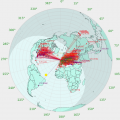jks
About
- Username
- jks
- Joined
- Visits
- 36,243
- Last Active
- Roles
- Member, Administrator, Moderator
- Points
- 639
Reactions
-
Connecting Kiwi via WiFi
Update to v1.311, then login to the Beagle as root and do the following:
Now look for these messages in the log where "eth0" is hopefully replaced with your USB WiFi's identifier. The last two lines should have the local network address of the WiFi interface. Connecting to the admin page should now work.cdp mst cdk nano admin.json [or other text editor of your choice] [go to end of file and replace "options":0 with "options":1] [save changes] cdp ku [wait 1 minute] msSep 12 00:55:28 www kiwid[1551]: 00:00:32.181 ... getifaddrs: IF lo fam=17 flags=0x10049 UP RUNNING Sep 12 00:55:28 www kiwid[1551]: 00:00:32.188 ... getifaddrs: IF eth0 fam=17 flags=0x19043 UP RUNNING Sep 12 00:55:28 www kiwid[1551]: 00:00:32.191 ... getifaddrs: IF usb0 fam=17 flags=0x1003 UP Sep 12 00:55:28 www kiwid[1551]: 00:00:32.193 ... getifaddrs: IF lo fam=2 flags=0x10049 UP RUNNING Sep 12 00:55:28 www kiwid[1551]: 00:00:32.193 ... getifaddrs: IF eth0 fam=2 flags=0x19043 UP RUNNING Sep 12 00:55:28 www kiwid[1551]: 00:00:32.193 ... getifaddrs: CHECK eth0 fam=2 Sep 12 00:55:28 www kiwid[1551]: 00:00:32.194 ... DDNS: IF IPv4 0xc0a80167 /24 0xffffff00 eth0 Sep 12 00:55:28 www kiwid[1551]: 00:00:32.194 ... getifaddrs: IF usb0 fam=2 flags=0x1003 UP Sep 12 00:55:28 www kiwid[1551]: 00:00:32.194 ... getifaddrs: IF lo fam=10 flags=0x10049 UP RUNNING Sep 12 00:55:28 www kiwid[1551]: 00:00:32.194 ... getifaddrs: IF eth0 fam=10 flags=0x19043 UP RUNNING Sep 12 00:55:28 www kiwid[1551]: 00:00:32.194 ... getifaddrs: CHECK eth0 fam=10 Sep 12 00:55:28 www kiwid[1551]: 00:00:32.194 ... DDNS: IF IPv6 LINK-LOCAL /64 eth0 Sep 12 00:55:28 www kiwid[1551]: 00:00:32.194 ... DDNS: private IPv4 <192.168.1.103> 0xc0a80167 /24 0xffffff00 eth0 Sep 12 00:55:28 www kiwid[1551]: 00:00:32.194 ... DDNS: private IPv6 LINK-LOCAL /64 ff:ff:ff:ff:ff:ff:ff:ff:00:00:00:00:00:00:00:00: eth0 -
Find your Kiwi using my.kiwisdr.com
Got a Kiwi (running v1.330+) on your local network with an unknown local IP address? Like a new Kiwi out-of-the-box? Now from a browser on the same local network you can connect to my.kiwisdr.com and be automatically redirected to the Kiwi. The local IP address of the Kiwi will then show in the browser address bar.
This feature is similar to that provided by other IoT devices. It requires that the Kiwi have access to the Internet when it starts up. And that the computer running the browser is on the same local network as the Kiwi. If there are multiple Kiwis on the network the browser will display a table of Kiwis by serial number and a link that will connect to each one.
Our documentation lists 5 different methods of determining a Kiwi's IP address. But each has its limitations and disadvantages. Now there is a sixth method that is particularly convenient.
If you want to opt-out of your Kiwi sending this information to kiwisdr.com each time it starts then set the switch on the network tab of the admin page to NO: "Register this Kiwi on my.kiwisdr.com on each reboot?".
This feature has not been tested with IPv6 or mixed IPv4/IPv6 local networks. So there is likely some debugging required. -
Locked out by using the Admin page?
All there is at the moment is the user/admin guide ("operating information", which grew from the "quick start" page) http://kiwisdr.com/quickstart/index.html Even that is unfortunately incomplete (some commands and options are not documented).
There is a architecture design document, but it is very old and somewhat out-of-date: https://www.dropbox.com/s/i1bjyp1acghnc16/KiwiSDR.design.review.pdf?dl=1
There is no "tour" guide of the software/files. That was always a low-priority task. Sadly we don't have many software contributors, although the ones we do have are doing some absolutely stellar work. And of course our many forum contributors are providing a great service to our user base. -
S meter extension - prevent clearing? [fixed in v1.318]
-
S meter extension - prevent clearing? [fixed in v1.318]







